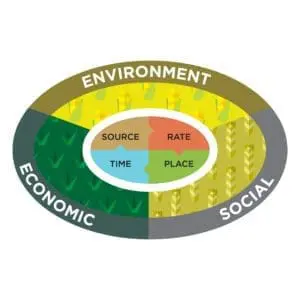Keep Nitrogen in the Root Zone for Better Yields
As corn growers plan their crop nutrient programs for top corn yields, it’s important to think about getting the most return from their investment, especially from nitrogen.
“Nitrogen is the most yield-limiting nutrient, and it is important for this nutrient to be available when the crop needs it most,” said Matt Werner, nutrition portfolio manager.
“The nitrogen needs of corn plants are highest during a short window of high growth from V6 to R3 when the plants are getting set for pollination and grain fill,” added Robb Mohr, branded nutrition manager.
Wilbur-Ellis agronomists like Werner and Mohr are available to help growers with all aspects of their crop nutrition plan to boost yields and get the most value from the products they are paying for. They also regularly remind growers of these proven strategies to help manage nitrogen and minimize losses to the environment.

Follow the 4Rs of Nutrient Stewardship.
Incorporating the right fertilizer source—at the right rate, time and place—helps to increase yield and minimize losses into the environment while improving resource stewardship and long-term sustainability of the farm business. Simply put, proper nutrient management helps keep nitrogen in the root zone while reducing nitrification and leaching.

“Our challenge is to not only keep nitrogen in the root zone but also to keep it out of the waterways and the environment,” said Werner. “Following the 4R approach for root zone fertilization both improves crop yields and minimizes nitrogen loss.”
- Right source: Consider both naturally available sources and specific products, in plant-available forms, to ensure a balanced supply of essential nutrients.
- Right rate: Collect soil samples, calculate crop removal rate and yield goals; then make decisions based on soil nutrient supply and plant demand.
- Right time and right place: Apply as close to the root zone as possible, and when the plant needs it, to ensure the best plant use of nitrogen. In corn, this includes an early-season application followed by applications at the V8, V9 and tassel stages.All nitrogen should be delivered to the corn plant before ears are set.
Splitting the total nitrogen application into two or more treatments is recommended. In-furrow applications at planting and again mid-season are effective ways to match the nitrogen applied to the needs of the corn plant throughout its life cycle—and to place the nutrient where it’s easiest for the crop to use it. For growers who irrigate, fertigation can be an effective way to spoon-feed nitrogen to the crop.
“Applying nitrogen when the crop needs it most, in a form that’s readily taken up by the crop makes the most sense in terms of your return on investment and environmental impact,” said Mohr.

Implement cultural practices.
Soil conservation best management practices (BMPs) like conservation tillage, no-till, cover crops or double cropping systems that increase organic matter in the soil are also tactics that help improve nitrogen stewardship and boost yields. They help control erosion, build soil biodiversity, and keep water and nutrients in the plant root zone longer.
- Conservation, or minimum tillage, is shown to improve soil health, reduce runoff and decrease carbon dioxide and greenhouse gas emissions. Minimizing mechanical operations and soil disturbance in a field can also decrease fuel expenditures and production costs.
- No-till, which doesn’t disturb the soil and leaves crop residue on the soil surface, is the most effective soil conservation system. “It is one of the best practices we’ve seen to help maximize what the grower is getting from their fertility and soil,” said Werner.
- Cover crops actively take up nitrate and ammonium from the soil, capturing this plant-available nitrogen that could leach and be lost into groundwater through field drainage systems. When held in the cover crop residue, nitrogen can be recycled for later use. This nutrient cycling provides nitrogen to crops and reduces the amount of fertilizer needed.
- Double cropping systems are gaining in popularity. This involves growing two crops in a field in the same year. “The goal is to always have something in the soil to help maximize yield and profitability,” said Mohr. In areas with adequate rainfall and a longer growing season, double-cropping soybeans with later planting dates adds nitrogen to the soil and keeps fields in production the entire season. Double cropping does pose unique challenges and a carefully defined management strategy is key.
Use nitrogen stabilizers to minimize potential losses due to weather and application timing.
Nitrogen applied can be lost due to volatility, leaching and denitrification. To minimize the possibility for loss, growers should consider protecting their targeted applications—plus their investments and the environment—with a nitrogen stabilizer.
Nitrogen stabilizers slow the conversion of nitrogen fertilizers to forms susceptible to loss. Backed by decades of data, these products also provide the following benefits:
- Improve crop use of applied nitrogen
- Help keep nitrogen in the root zone
- Prolong availability of nitrogen
- Decrease the impact of unpredictable weather
- Increase nitrogen uptake, availability, usage and efficiency
- Promote good stewardship of land and water resources
“Nitrogen stabilizers help take a lot of the risk out of one’s operation regarding N lost to the environment,” said Mohr. “They can be very effective and add great value to any farm in the Midwest when used in the right circumstances.”
From a timing standpoint, applying a stabilizer when and where your largest fertilizer investment is best helps to protect those dollars. However, the decision whether to use this type of technology must be made before knowing the effect weather will play each season.
“In general, we recommend applying the stabilizer and dialing the rate based on how efficient the nitrogen is,” Werner added. Partnering with your local agronomist can help you choose the best product whether you apply anhydrous, urea, UAN or another N source.
Complete nutrient solutions offer flexibility and other management benefits.
As nutrient management has become more precise, products that combine several nutrients have been created to better align with crop needs. Complete nutrient solutions give growers flexibility and high yield potential.

For example, TILL-IT FLUID CARBON can replace a standard UAN program. This liquid nitrogen source is formulated with both humic acid which helps increase nutrient availability and soil health, and the nitrification inhibitor NDURE DCD, which protects below-ground nitrogen from loss due to denitrification, especially in wet soils.
“We feel like it’s one of the best ways to apply nitrogen on the market,” Werner concluded. “The ‘all-in-one’ solution addresses multiple potential events that can happen in a season—protecting against nitrogen loss while ensuring that what is protected is taken up by the plant.”
Research backs the benefits.
One of the most frequent questions growers ask is the cost-effectiveness of these nitrogen management practices, including the use of stabilizers and methods like split fertilizer applications.
Wilbur-Ellis has more than a decade of research proving these technologies and approaches work; our team of field development specialists and agronomists trial products and split apply acres every year to show how growers can get the most from different nitrogen management programs.
For questions about which products and practices make the most sense for your operation, contact your local Wilbur-Ellis retailer or agronomist.
###

